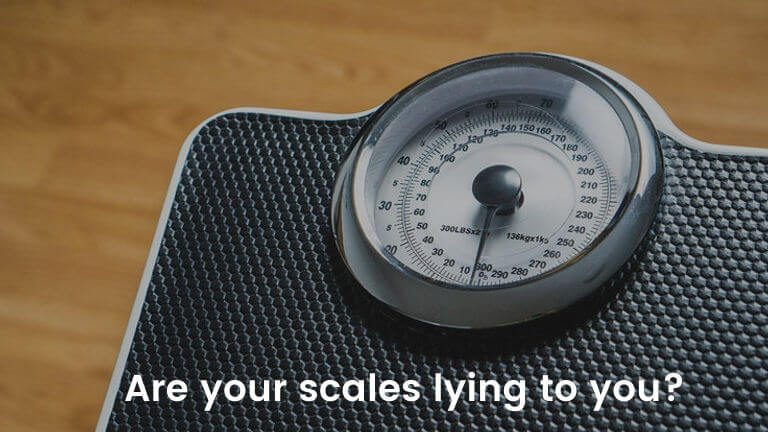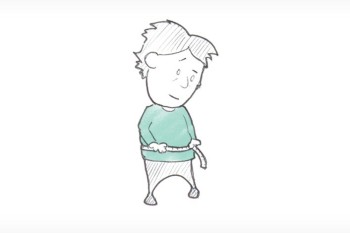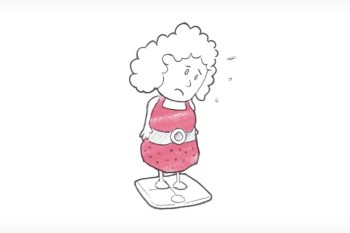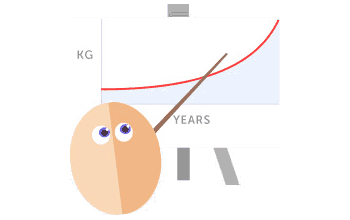Most of your body is water, and that is the main thing the scales measure. When we say “I want to lose weight”, what we really mean is “I want to lose fat”, but the scales cannot measure body fat directly. Even if you have a body fat analyser scale you do not get a very accurate percentage figure for body fat and this percentage figure is strongly influenced by changes in body water (if your body has a higher percentage of water, the percentage of fat must be lower as the percentage figure has to add up to 100!). Although our bodies have mechanisms in place to keep our water levels reasonably steady, these are not very precise and even if you matched your calorie intake exactly with your body’s energy needs, you would see a considerable daily variation in weight. For people eating a normal, varied diet, this variation can be very large – over 2kg! This is easily enough to hide the loss of fat caused by your fasting efforts for quite a while.
What affects the weight you see on the scales?
1) Food
Food has weight. When you fast, you have less of it in your digestive system and your scales will reflect this. When you finish the fast day and go back to normal eating, that adds to your scale weight. It’s not a bad thing, just something to remember.
2) Electrolyte balance
Your body aims to keep the amounts of sodium and potassium in your body balanced and this can affect your body water. If you eat a diet high in carbohydrates you’ll tend to retain sodium, whereas when you fast or eat a low carbohydrate diet, you’ll excrete sodium and lose water (you may have noticed you have to visit the bathroom a lot on fast days), which will result in a lower weight on the scales.1 When you, for example, overdo the carbs or eat a lot of salty food, you end up holding onto more water. That can give you a soft, puffy look, make you feel bloated and result in a higher scale weight. It’s not fat, even if it makes you feel fat!
3) Exercise
All exercise, including weight training and even cardio, causes some muscle damage. This results in inflammation and water retention during the repair process. Further, exercise increases the size of your glycogen stores, particularly if you do high intensity exercise training.2 As glycogen is two-thirds water by weight, it’s clear that exercise increases how much water your body holds and in turn increases your weight. If you have started new exercise and you think your weight loss has stalled, it is more likely that you are losing fat but gaining water.
Read more about exercise and fasting
4) Hormones
Your water balance is largely governed by the hormone, aldosterone. Drinking more water causes you to decrease aldosterone production, which tells your kidneys to release water in their filtering process. Letting yourself go thirsty has the opposite effect, so you retain more water.3
Stress hormones also increase water retention, and fasting is stressful to your body. There is a direct link between the calorie deficit and cortisol levels.4 Cortisol not only causes water retention but increases insulin resistance.5 When you eat normally again, cortisol drops and so does your weight. This is one possible reason why some fasters report a bigger decrease in the scales after the first day of normal eating after a fast than on the morning after the fast day itself. Other kinds of stress, such as exercise, emotional stress, illness and so on will also increase cortisol and so affect your weight.
Learn about stress and fasting
For women, of course, there is also pre-menstrual hormone changes to consider. In this case water retention is caused by the temporary hormonal changes. Also you may feel extra hungry at this time of the month: do try to resist any urges to overeat, particularly high carbohydrate foods, as this is the worst time to do so. You’ll feel even more bloated than usual.
5) Fat loss
Finally we get to fat loss! But it’s not what you think: as you are losing fat the body tends to increase the water content of the adipose tissue (your fat stores).6 When you lose fat you may notice that your fatty areas develop a softer, squishier appearance than before. This is an indication that fat has been lost and your body is storing water. Eventually, the body reduces the water held in the adipose tissue and you may experience the ‘whoosh’ effect, whereby you see a sudden drop in weight after days (or weeks) of weighing the same.
And of course, behind all of this you are losing actual fat, which will of course affect your weight on the scales but will likely be hidden by all the changes in body water going on until you have lost enough fat to ‘outweigh’ the water fluctuations.
If the scales are so unreliable, how do I know if I’m losing weight?
Use other means to track progress, such as tape measure, progress pictures, and how clothes fit.
Have confidence in your fasting plan. Follow it faithfully for a month before deciding how you’re doing. Don’t be tempted to start doubting and give up too soon.
Look at the overall trend. If you lose 4kg in the first 2 weeks, and now its week 4 and the scale hasn’t moved, you still are at 1kg/week average. That should already be above your weekly expected fat loss: the average loss using the 5:2 diet is only 0.5kg per week. Weighing daily rather than weekly and plotting the trend on a graph will give you a much clearer indication of your progress. While that might sound daunting, using the FastDay progress tracker makes it simple. If you can see the trend line going down you won’t be disheartened by the normal daily variations.
Remember that when you lose 4kg in the first 2 weeks it is not all fat, it is not even mostly fat: it is mostly water. Resolve to stick to your chosen fasting method until you can be certain whether it is working – at least a month.














